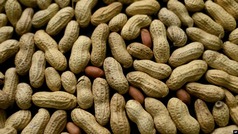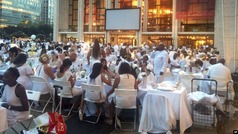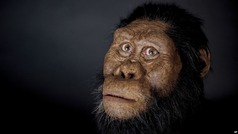AS IT IS
Doctors: Give Babies Crushed Peanuts to Reduce Allergy Risk
September 02, 2019
ピーナッツアレルギーの発症を防ぐためには、0歳の頃から食べるほうがいいという研究を紹介した記事。
Doctors are advising parents to feed babies peanut products before their first birthday to reduce the child’s risk of developing a peanut allergy.(医師たちは、子供がピーナッツアレルギーを発症するリスクを減らすために、最初の誕生日の前から赤ちゃんにピーナッツ製品を食べさせるよう、両親に勧めている。)
A team of allergy experts and child care specialists wrote the new guidance. They suggest adding soft, crushed peanuts to a baby’s diet beginning at four months of age. They say babies should continue to get “substantial” amounts of peanut products in their first year of life.(アレルギーの専門家と育児の専門家のチームが新しいガイダンスを作成した。彼らは、生後4ヶ月から赤ちゃんの食事に柔らかい砕いたピーナッツを加えることを提案している。彼らは、赤ちゃんは生後1年間「相当な」量のピーナッツ製品を摂取し続けるべきだと述べている。)
The new guidance is a “complete reversal” from earlier advice to parents, noted Doctor Ruchi Gupta. Earlier guidelines suggested waiting to feed children peanut products until they were much older.(新しいガイダンスは、両親向けのそれまでのアドバイスと「全くの逆」であると、Ruchi Gupta博士は述べている。以前のガイドラインでは、子供にピーナッツ製品を食べさせのは、ずっと大きくなるまで待つよう勧めている。)
The study involved 640 babies, all of whom were younger than 11 months. Each child had either an egg allergy or the skin condition eczema. Both disorders increase the child’s risk for developing a peanut allergy. But researchers found that when these high-risk babies were fed a small amount of peanut butter three times a week, only three percent went on to develop the allergy after five years. By comparison, 17 percent of children who avoided peanuts became allergic.(この研究には640人の赤ちゃんが参加し、全員が11ヶ月未満だった。それぞれの子供は卵アレルギーまたは皮膚疾患の湿疹のいずれかを持っていた。どちらの疾患も、子供がピーナッツアレルギーを発症するリスクを高めるものだ。しかし研究者たちは、こうした高リスクの赤ちゃんが週に3回、少量のピーナッツバターを与えられたとき、5年後にアレルギーの発症に至ったのはわずか3%であったことを発見した。比較すると、ピーナッツを避けた子供は17パーセントがアレルギーになった。)
The method of early introduction has also been tested with other major allergenic foods, like milk, egg, fish and wheat. The method has been especially effective for both egg and peanut allergies, experts note.(早期導入という手法は、他の主要なアレルギー誘発性食品でもテストされている。例えば牛乳、卵、魚、小麦などで。この方法は、卵アレルギーとピーナッツアレルギーの両方で特に効果的であると専門家は述べている。)
これって科学の怖いところですよね。「今まで医者が患者に指示してきたことは完全な間違いでした。正解は実は真逆でした、テヘペロ。」みたいなことが21世紀になってもちょくちょく起きる。だから疑心暗鬼になって現代医学を信じられなくなり、怪しげな代替医療に走ったりする人が出てくる。
SCIENCE & TECHNOLOGY
Can Modern Science Stop Hurricanes?
September 01, 2019
科学の力で台風は止められるのか?という記事。
An American website reported last month that President Donald Trump asked U.S. government officials to explore using nuclear bombs to stop hurricanes. It claimed that Trump had suggested the targeted use of nuclear bombs to protect the United States against the storms.(アメリカのあるウェブサイトは先月、ドナルド・トランプ大統領がハリケーンを止めるために核爆弾の使用を検討するよう合衆国政府関係者に要請したと報じた。合衆国を嵐から守るための標的を絞った核爆弾の使用をトランプが提案したと同サイトは主張している。)
この話はガセで、トランプ大統領はそのようなことを言っていなかったのですが、The U.S. National Oceanic and Atmospheric Administration, or NOAA,(アメリカ海洋大気庁)によれば、
The scientific agency says it often receives suggestions that nuclear weapons should be used against hurricanes. NOAA addresses the “nuking” of storms on its website. “Needless to say, this is not a good idea,” it says.(この科学分野の官庁は、ハリケーンに対して核兵器を使用すべきだという提案をしばしば受けると言っている。 NOAAはウェブサイト上で嵐への「ぶちのめし」に対処している。 「言うまでもありませんが、これは良いアイデアではありません」と書かれている。)(動詞の'nuke'には「核攻撃する」の他に「ぶちのめす」という意味がある。“nuking”をダブルコーテーションでくくっているのはジョーク的意図と解釈したが、間違ってるかも)
NOAA made an estimate of the amount of energy required to weaken the strength of a Category 5 hurricane to that of a Category 2 storm. It predicted that would require more than 500 million tons of air to hit a storm with a 20-kilometer-wide eye. It would be very difficult to find “a practical way of moving that much air,” the agency noted.(NOAAは、カテゴリー5の強さのハリケーンをカテゴリー2の強さの嵐に弱めるのに必要なエネルギー量を推定した。幅20キロメートルの目を持つ嵐を撃つためには、5億トン以上の空気が必要になると予測されている。 「それほど多くの空気を移動させる実用的な方法」を見つけることは極めて困難だろうと同局は述べている。)
VOAの記事には、嵐を弱めるための、科学者が検討したが今のところ現実的ではない方法が二つ紹介されています。
Seeding storm clouds(嵐雲への種まき)
Scientists used a substance called silver iodide, which can form ice crystals. The goal was to drop silver iodide into hurricane rain clouds. Scientists theorized that the process would weaken wind strength and reduce the storm’s intensity.
(科学者は、氷の結晶を生成できるヨウ化銀と呼ばれる物質を使用した。目標は、ヨウ化銀をハリケーンの雨雲に落とすことだ。科学者は、この処置が風の強さを弱め、嵐の激しさを緩和させるという理論を立てた。)
But in the end, NOAA decided that cloud seeding had little chance of success.(しかし最終的にNOAAは、雲への種まきが成功する可能性はほとんどないと判断した。)
もう一つは
Cooling sea water(海水の冷却)
そりゃ無理でしょ。
ARTS & CULTURE
Why Americans Don’t Wear White after Labor Day
September 01, 2019
アメリカにおけるレイバー・デーと白い服の関係について紹介する記事。
This Monday is Labor Day in the United States - a holiday linked to workers’ rights and wearing white.(今週の月曜日は合衆国では「労働者の日」だが、それは労働者の権利と、白い服を着ることに関連した祝日だ。)
That may sound strange, but it is true. Many Americans put away their white clothes on Labor Day and do not wear them again until the following May, after Memorial Day.(それは奇妙に聞こえるかもしれないが、本当のことだ。多くのアメリカ人はレイバー・デーに白い服を片付け、翌年5月、戦没将兵追悼記念日の後までそれを再び着ることはない。)
その理由は富裕層の慣習にあるとしています。
Then, in about the 1930s, wearing white clothes in the summertime became fashionable, too. That is because some wealthy Americans in Northeast cities went on vacation for weeks or months in the summer. They stayed in costly hotels or summerhouses. The white clothes they wore there became linked to ease, beauty and money. But at the end of summer, around Labor Day, they put those white clothes away and returned to their lives in the city - as well as to their darker, heavier clothes.(その後1930年代頃、夏季に白い服を着るのはおしゃれなことにもなった。その理由は、北東部の都市に住む富裕なアメリカ人の一部が、夏に数週間から数ヶ月間の休暇を取ったためだ。彼らは高価なホテルや避暑用の別荘に宿泊した。彼らがそこで着ていた白い服は、くつろぎ、美しさ、そしてお金と結びついていた。しかし夏の終わり、レイバー・デーの頃になると、彼らは白い服をしまい込み都市の生活に戻っていった、そして同時により暗く、より厚い服に。)
In time, not wearing white after Labor Day became a bit of a fashion rule. Following it showed that you were wealthy -- or at least that you knew how to act like you were.(やがて、レイバー・デー後は白い服を着ないことがファッションのちょっとした規範になった。そのルールに従うことは、あなたが裕福であるか、少なくともlike you were[訳出来ず]どう振る舞うべきか知っていることを示していた。)
富裕層の慣習を真似ることが広まった、ということです。ファッション誌は「そんなルールは無視しよう」と書いているそうですが、むしろ今でもそんな慣習が残ってるの?
But you may want to be careful about wearing white to an American-style Labor Day barbecue. The trouble is not fashion - it is ketchup. If it spills, the popular red tomato sauce can ruin a nice set of clothes(それでも皆さんは、アメリカ流のレイバー・デーのバーベキューで白い服を着ることは用心したいかもしれません。悩みの種はファッションではなくケチャップです。もしこぼれたら、人気の赤いトマトソースは素敵な服の一揃いを台無しにします。)
締めはアメリカンジョーク。
AS IT IS
Fears Grow Over Heat Dangers at Tokyo 2020 Olympics
September 01, 2019
東京オリンピックは暑すぎるのではないかという不安が高まっているという記事。
There are growing concerns that heat and humidity during the Olympic Games in Tokyo next summer could be dangerous to the athletes.(来年の夏の東京オリンピックでの暑さと湿度は、選手にとって危険ではないかという懸念が高まっている。)
Summer temperatures in the Japanese capital often reach 35 degrees Celsius or higher. There also is strong sunshine and humidity can reach 80 percent.(日本の首都の夏の気温は摂氏35度もしくはそれ以上になることがしばしばある。また強い日差しもあり、湿度は80%に達する場合もある。)
Earlier this month, a worker at the Olympic building area in the city died from heat stroke.(今月これまでに、市内のオリンピック建設地域で作業員が一人熱中症で死亡している。)(正しくはthis monthじゃなくて「8月に」だけど)
This year, high temperatures beginning in late July were blamed for the deaths of at least 57 people.(今年、7月下旬から始まった高温は少なくとも57人の死者の原因となっている。)
George Havenith is an expert on the effects of temperature and climate on athletes at Britain's Loughborough University. He said the heat and humidity could be dangerous.(英国ラフバラ大学のGeorge Havenithは、運動選手に対する温度や気候の影響に関する専門家だ。彼は、暑さと湿度が危険な可能性があると述べている。)
"Having ice baths available for the athletes to cool them down quickly…it's very important to have that, because if you decide to (take) them to the hospital before you do the cooling, you put them at risk.”(「選手をすぐに冷やせるように氷水の風呂が用意されていること…、その用意が非常に重要です。なぜなら、冷やす前に病院に(連れて)行くことを決めたら、選手を危険にさらすからです。」)(very important to have thatの'to have that'の訳に自信なし)
Tokyo last held the Olympics in 1964. At that time, the Games were moved to October to avoid the summer heat. That is no longer possible because of the demands of international broadcasters.(東京は前回1964年にオリンピックを開催した。その時は、夏の暑さを避けるためにオリンピックは10月に移動した。世界の放送局からの要求により、それはもはや不可能だ。)
冗談抜きで選手スタッフ観客に死者が出そうな雲行きだけど、断固として「そのまま実施します」感が恐ろしい。
HEALTH & LIFESTYLE
Eating More Plant Protein May Help You Live Longer
September 01, 2019
植物性のタンパク質が体に良いという日本の研究を紹介する記事。
People who eat more plant-based protein may live longer than those who get more protein from meat, a Japanese study suggests.(植物由来のタンパク質をより多く摂取する人は、より多くのタンパク質を肉から摂取する人よりも長生きする可能性があることを日本の研究が示している。)
Researchers followed almost 71,000 middle-aged Japanese adults for an average of almost 20 years. They compared people who ate the smallest amount of plant protein to those who ate the largest amount. The researchers found that those who ate the most were 13 percent less likely to die during the study. They were also 16 percent less likely to die of cardiovascular causes.(研究者は、7万1,000人近い中年の日本人成人を平均でほぼ20年間追跡し、最小量の植物性タンパク質を食べた人と最大量を食べた人とを比較した。研究者は、最も多く食べた人は、研究中に死亡する可能性が13%低かったことを発見した。また心臓血管系の原因で死亡する可能性は16%少なかった。)
類似の研究結果は以前からあったが、
But most of those studies were done among Western populations, he said. “In this Japanese study, consumption of plant protein is quite high, whereas the consumption of animal protein is quite low compared to that in Western populations,” he said.(しかし、そうした研究のほとんどは西洋人で行われたと彼は述べている。彼によれば 「この日本の研究では、植物性タンパク質の消費量は非常に多く、一方で動物性タンパク質の消費量は西洋人と比較するとかなり少ない」。)
People who replaced just 3 percent of red meat with plant protein were 34 percent less likely to die of any cause. They were 39 percent less likely to die of cancer, and 42 percent less likely to die of heart disease during the study.(赤身肉のわずか3パーセントを植物性タンパク質に置き換えた人は、何らかの原因で死亡する可能性が34パーセント低かった。その人たちは研究期間中にガンで死亡する可能性が39%低く、心臓病で死亡する可能性は42%低かった。)
And, those who replaced just 4 percent of processed meat in their diet with plant protein were 46 percent less likely to die of any cause. They were 50 percent less likely to die of cancer.(また、食事に含まれる加工肉のわずか4%を植物性タンパク質に置き換えた人は、何らかの原因で死亡する可能性が46%低く、ガンで死亡する可能性は50%少なかった。)
これほど大規模かつ長期の研究を日本の研究者らが行っていたのは素晴らしいことですが、ちょっと検索した限りでは日本語の記事が見つかりません。いったいどこの大学なんだろう?
SCIENCE & TECHNOLOGY
Ethiopian Fossil Face Could Be Ancestor of Famed ‘Lucy’
August 31, 2019
アウストラロピテクスの完全に近い頭蓋骨が見つかり、顔が復元されたという記事。
A fossil from Ethiopia is letting scientists look deep into the past and they see a face looking back.(エチオピアのある化石が科学者たちに過去をずっと奥までのぞき込ませている。そして彼らは振り返った顔を見ているのだ。)
The fossil is estimated to be 3.8 million years old. It helps complete the face for what scientists believe to be an ancestor of the species represented by Lucy -- the celebrated Ethiopian skeleton found in 1974.(その化石は380万年前の物だと推定されており、それはルーシーに代表される種の祖先だと科学者が考えているものの顔を完成させる役に立つ。ルーシーとは、1974年に発見された有名なエチオピアの人骨のことだ。)
This species is the oldest known member of Australopithecus, a group of creatures that came before our own group of species.(この種は、知られている中で最古のアウストラロピテクスの仲間で、アウストラロピテクスとは私たち自身の種のグループよりも前に現れた生物のグループだ。)
Scientists call it A. anamensis. They have known for a long time that the species existed. Fossil remains of it that are over 4 million years ago have been found. But remains of the species' face bones that had been found before were limited to pieces of jaws and teeth. This made it difficult to fully understand the species.(科学者はそれをA. anamensis(アウストラロピテクス・アナメンシス)と呼んでいる。その種が存在することはずっと前から知られており、400万年以上前のこの種の化石が発見されたことがある。しかし、これまでに発見されたこの種の遺骨の顔の骨は、顎と歯の断片に限定されていた。それが、この種を完全に理解することを困難にしていた。)
The newly reported fossil includes much of the skull and face. The skull helps scientists learn about a specie's diet, brain size and appearance.(新たに報告された化石には、頭蓋骨と顔の大部分が含まれている。頭蓋骨は、科学者がこの種の食生活、脳の大きさ、そして容姿について学ぶのに役に立つ。)
“This is a once-in-a-lifetime discovery,” he told the Reuters news agency. “We are talking about the most complete cranium of an early human ancestor ever found…”(「これは一生に一度の発見です」と彼はロイター通信に語っている。 「我々が話しているのは、これまでに発見された初期人類の祖先の最も完全な頭蓋のことなんです…」)






コメント